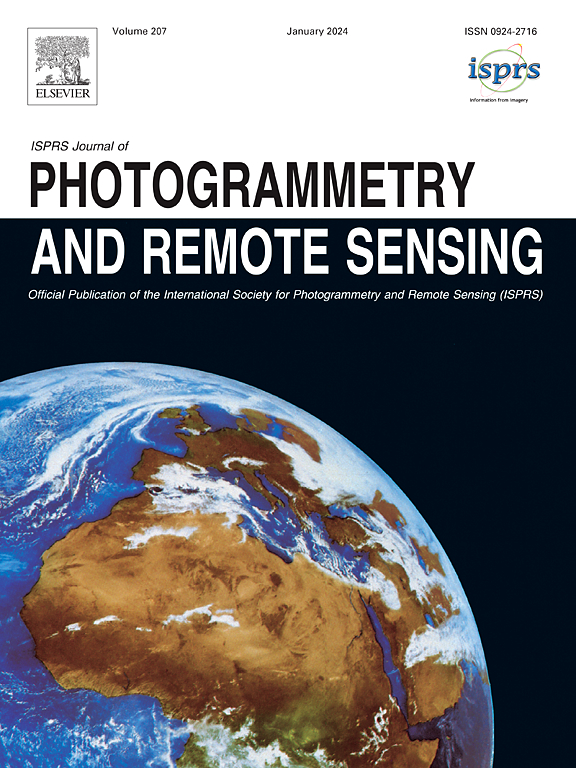Simulation-aided similarity-aware feature alignment with meta-adaption optimization for SAR ATR under extended operation conditions
IF 10.6
1区 地球科学
Q1 GEOGRAPHY, PHYSICAL
ISPRS Journal of Photogrammetry and Remote Sensing
Pub Date : 2025-02-19
DOI:10.1016/j.isprsjprs.2025.01.027
引用次数: 0
Abstract
Synthetic Aperture Radar (SAR) image characteristics are highly susceptible to variations in the radar operation condition. Meanwhile, acquiring large amounts of SAR data under various imaging conditions is still a challenge in real application scenarios. Such sensitivity and scarcity bring an inadequately robust feature representation learning to recent data-hungry deep learning-based SAR Automatic Target Recognition (ATR) approaches. Considering the fact that physics-based electromagnetic simulated images could reproduce the image characteristics difference under various imaging conditions, we propose a simulation-aided domain adaptation technique to improve the generalization ability without extra measured SAR data. To be specific, We first build a surrogate feature alignment task using only simulated data based on a domain adaptation network. To mitigate the distribution shift problem between simulated and real data, we propose a category-level weighting mechanism based on SAR-SIFT similarity. This approach enhances surrogate feature alignment ability by re-weighting the simulated samples’ features in a category-level manner according to their similarities to the measured data. In addition, a meta-adaption optimization is designed to further reduce the sensitivity to the operation condition variation. We consider the recognition of the targets in simulated data across imaging conditions as an individual meta-task and adopt the multi-gradient descent algorithm to adapt the feature to different operation condition domains. We conduct experiments on two military vehicle datasets, MSTAR and SAMPLE-M with the aid of a simulated civilian vehicle dataset, SarSIM. The proposed method achieves state-of-the-art performance in extended operation conditions with 88.58% and 86.15% accuracy for variations in depression angle and resolution, outperforming our previous simulation-aided domain adaptation work TDDA. The code is available at https://github.com/ShShann/SA2FA-MAO.
扩展作战条件下SAR ATR的模拟辅助相似感知特征对齐与元适应优化
合成孔径雷达(SAR)的图像特性极易受到雷达工作条件变化的影响。同时,在实际应用场景中,获取大量不同成像条件下的SAR数据仍然是一个挑战。这种敏感性和稀缺性使得目前基于深度学习的SAR自动目标识别(ATR)方法缺乏足够的鲁棒性。考虑到基于物理的电磁模拟图像能够再现不同成像条件下的图像特征差异,提出了一种模拟辅助域自适应技术,以提高在不需要额外测量SAR数据的情况下的泛化能力。具体而言,我们首先基于域自适应网络构建仅使用模拟数据的代理特征对齐任务。为了缓解模拟数据与真实数据之间的分布偏移问题,提出了一种基于SAR-SIFT相似度的类别级加权机制。该方法通过根据模拟样本的特征与测量数据的相似度,以类别级别的方式重新加权模拟样本的特征,从而增强了代理特征对齐能力。此外,设计了元自适应优化,进一步降低了对运行工况变化的敏感性。我们将模拟数据中的目标识别作为一个独立的元任务,并采用多梯度下降算法使特征适应不同的操作条件域。我们在军用车辆数据集MSTAR和SAMPLE-M上进行了实验,并借助模拟民用车辆数据集SarSIM进行了实验。该方法在扩展操作条件下,对俯角和分辨率变化的准确率分别为88.58%和86.15%,优于我们之前的仿真辅助域自适应工作TDDA。代码可在https://github.com/ShShann/SA2FA-MAO上获得。
本文章由计算机程序翻译,如有差异,请以英文原文为准。
求助全文
约1分钟内获得全文
求助全文
来源期刊

ISPRS Journal of Photogrammetry and Remote Sensing
工程技术-成像科学与照相技术
CiteScore
21.00
自引率
6.30%
发文量
273
审稿时长
40 days
期刊介绍:
The ISPRS Journal of Photogrammetry and Remote Sensing (P&RS) serves as the official journal of the International Society for Photogrammetry and Remote Sensing (ISPRS). It acts as a platform for scientists and professionals worldwide who are involved in various disciplines that utilize photogrammetry, remote sensing, spatial information systems, computer vision, and related fields. The journal aims to facilitate communication and dissemination of advancements in these disciplines, while also acting as a comprehensive source of reference and archive.
P&RS endeavors to publish high-quality, peer-reviewed research papers that are preferably original and have not been published before. These papers can cover scientific/research, technological development, or application/practical aspects. Additionally, the journal welcomes papers that are based on presentations from ISPRS meetings, as long as they are considered significant contributions to the aforementioned fields.
In particular, P&RS encourages the submission of papers that are of broad scientific interest, showcase innovative applications (especially in emerging fields), have an interdisciplinary focus, discuss topics that have received limited attention in P&RS or related journals, or explore new directions in scientific or professional realms. It is preferred that theoretical papers include practical applications, while papers focusing on systems and applications should include a theoretical background.
 求助内容:
求助内容: 应助结果提醒方式:
应助结果提醒方式:


